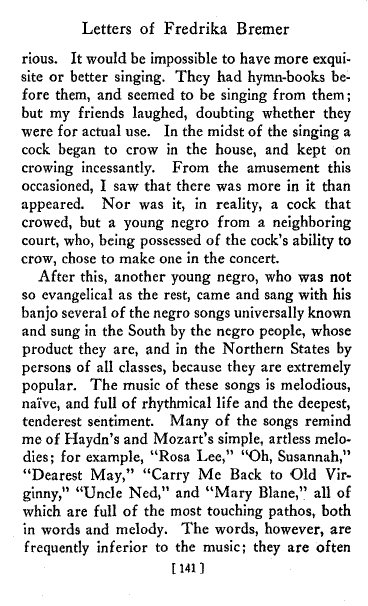
Full resolution (TIFF) - On this page / på denna sida - Columbia, South Carolina, May 25

<< prev. page << föreg. sida << >> nästa sida >> next page >>
Below is the raw OCR text
from the above scanned image.
Do you see an error? Proofread the page now!
Här nedan syns maskintolkade texten från faksimilbilden ovan.
Ser du något fel? Korrekturläs sidan nu!
This page has been proofread at least once.
(diff)
(history)
Denna sida har korrekturlästs minst en gång.
(skillnad)
(historik)
glorious. It would be impossible to have more
exquisite or better singing. They had hymn-books
before them, and seemed to be singing from them;
but my friends laughed, doubting whether they
were for actual use. In the midst of the singing a
cock began to crow in the house, and kept on
crowing incessantly. From the amusement this
occasioned, I saw that there was more in it than
appeared. Nor was it, in reality, a cock that
crowed, but a young negro from a neighboring
court, who, being possessed of the cock’s ability to
crow, chose to make one in the concert.
After this, another young negro, who was not
so evangelical as the rest, came and sang with his
banjo several of the negro songs universally known
and sung in the South by the negro people, whose
product they are, and in the Northern States by
persons of all classes, because they are extremely
popular. The music of these songs is melodious,
naïve, and full of rhythmical life and the deepest,
tenderest sentiment. Many of the songs remind
me of Haydn’s and Mozart’s simple, artless melodies;
for example, “Rosa Lee,” “Oh, Susannah,”
“Dearest May,” “Carry Me Back to Old Virginny,”
“Uncle Ned,” and “Mary Blane,” all of
which are full of the most touching pathos, both
in words and melody. The words, however, are
frequently inferior to the music; they are often
<< prev. page << föreg. sida << >> nästa sida >> next page >>